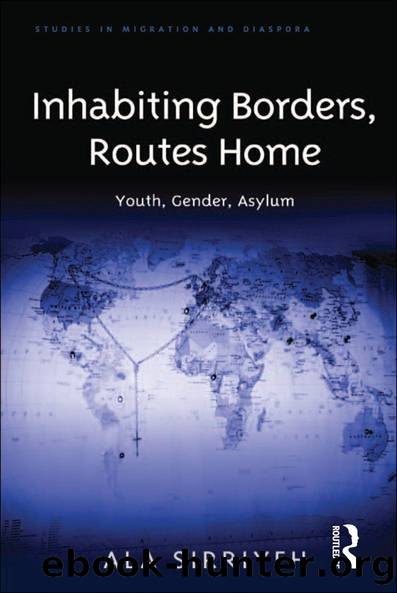Inhabiting Borders, Routes Home by Ala Sirriyeh

Author:Ala Sirriyeh [Sirriyeh, Ala]
Language: eng
Format: epub
Tags: Social Science, Emigration & Immigration
ISBN: 9781317116684
Google: jSo3DAAAQBAJ
Publisher: Routledge
Published: 2016-05-23T03:22:57+00:00
The âRight to have Rightsâ
Agier (2008: 49) describes the refugee camp as a place of waiting where âdurable life is not supposed to exist in a space outside of place, a moment outside of time.â While physically located within the city and living within the local communities, those women who were still waiting to hear the outcomes of their asylum claims described not necessarily the total absence of durable life, but certainly its curtailment. As noted in Chapter 3, this was often made more apparent through their observations of others who lived in close proximity and who entered their lives, but who occupied different worlds of entitlement and access to mobility. Attaining refugee status, and the legal rights and entitlements associated with this status was seen as central to establishing durable life and a sense of normality or continuity. Sophie (West African, 18) lived alone with her baby son in a flat that was in poor repair and which she was desperate to leave. She was not engaged in any social activities outside the house and described feeling isolated and deeply unhappy. Having already experienced failed attempts to negotiate improvements to her living conditions when she had not been listened to, the only way she could envisage any positive development was âif my situation changes, with immigration, my asylum caseâ. Ella (Middle Eastern, 18) had been in the UK for four years while her family waited for their asylum claim to be concluded. She photographed some chain railings around a childrenâs playground and referred to the chains to describe the restrictions she saw being placed on people seeking asylum in the UK. She explained the photograph saying, âItâs the idea of chains making you feel like you in prison. Itâs like when we first came here you donât have the permission to go to other places. You feel constricted.â The status of âasylum seekerâ was linked to prolonged situations of dependence, conditionality and crucially restrictions on the ability to exert agency and control over their lives.
Writing in the aftermath of the two World Wars, in The Origins of Totalitarianism Arendt (1958) observed that the supposedly inalienable human rights described in the Rights of Man were in fact dependent on access to citizenship in the nation-state system. Without the right of membership to these political communities that could in theory guarantee and protect rights, stateless people had found that they not only lost their citizenship rights, but also their human rights. Arendt called for the right of every human being to belong to such a community as this was in effect the âright to have rightsâ. The second half of the twentieth century saw the establishment of international institutional arrangements that seek to guarantee and protect rights at a supra-national level, such as the 1951 Geneva Convention Relating to the Status of Refugees, the 1989 UN Convention on the Rights of the Child and the establishment of the UN High Commissioner on Refugees in 1950, the European Court of Human Rights in 1953 and the International Criminal Court in 2002 (Benhabib 2004).
Download
This site does not store any files on its server. We only index and link to content provided by other sites. Please contact the content providers to delete copyright contents if any and email us, we'll remove relevant links or contents immediately.
Chaco's Northern Prodigies : Salmon, Aztec, and the Ascendancy of the Middle San Juan Region after AD 1100 by Paul F. Reed(346)
Law Enforcement Interpersonal Communication and Conflict Management by Brian Douglas Fitch(341)
Digital International Relations by Unknown(336)
Critical Perspectives on Human Security : Rethinking Emancipation and Power in International Relations by David Chandler; Nik Hynek(322)
Skilled interpersonal communication: Research, theory and practice, Fifth edition by Owen Hargie(318)
The Enduring Color Line in U.S. Athletics by Krystal Beamon Chris M. Messer(317)
Evidence-Based Policy Making in Labor Economics by Hamermesh Daniel S.;Nottmeyer Olga K.;Nottmeyer Olga;King Sarah;King Sarah;King Sarah;(290)
EPSO CAST Political affairs EU policies: How to succeed in the selection procedure by Franco Reverte José María(281)
Criminological Theory in Context by John Martyn Chamberlain(264)
Writing Public Policy - A Practical Guide to Communicating in the Policy Making Process by Catherine F. Smith(263)
Threshold Concepts in Women's and Gender Studies by Christie Launius Holly Hassel(259)
Tibeton Yoga Its Secret Doc by Evans-Wentz(255)
Positive Psychology and Spirituality in Counselling and Psychotherapy (Conflict, Ethics, and Spirituality, 12) by unknow(254)
Social Problems, Social Issues, Social Science by James Wright(253)
Rothschild and Early Jewish Colonization in Palestine (Geographical Perspectives on the Human Past) by Ran Aaronsohn(253)
Play in child development and psychotherapy: toward empirically supported practice by Sandra W. Russ(247)
Cognitive Development in Infancy and Childhood (Elements in Child Development) by Mary Gauvain(245)
Latin American Politics and Society by Gerardo L. Munck & Juan Pablo Luna(216)
What Makes a Social Crisis?: The Societalization of Social Problems by Jeffrey C. Alexander(215)
